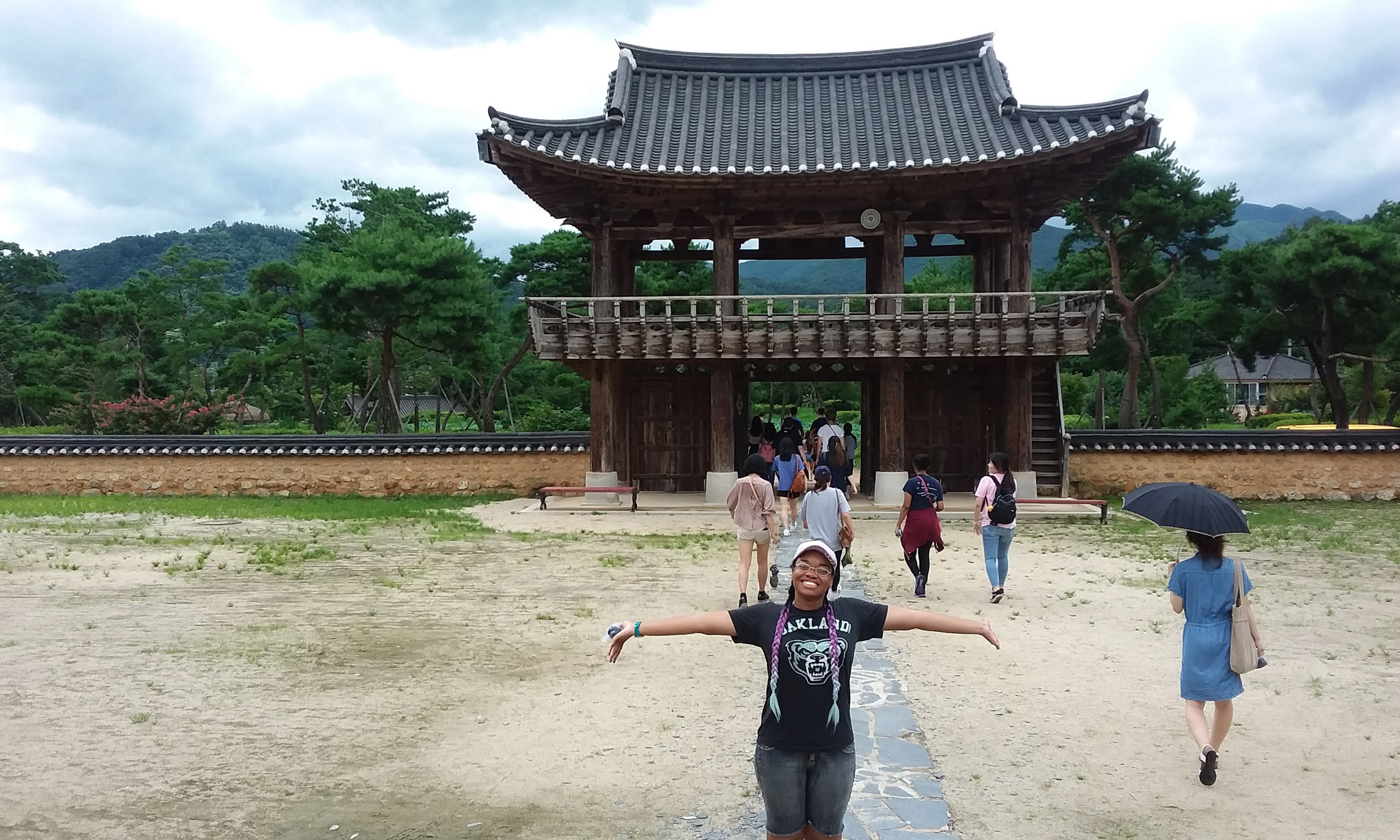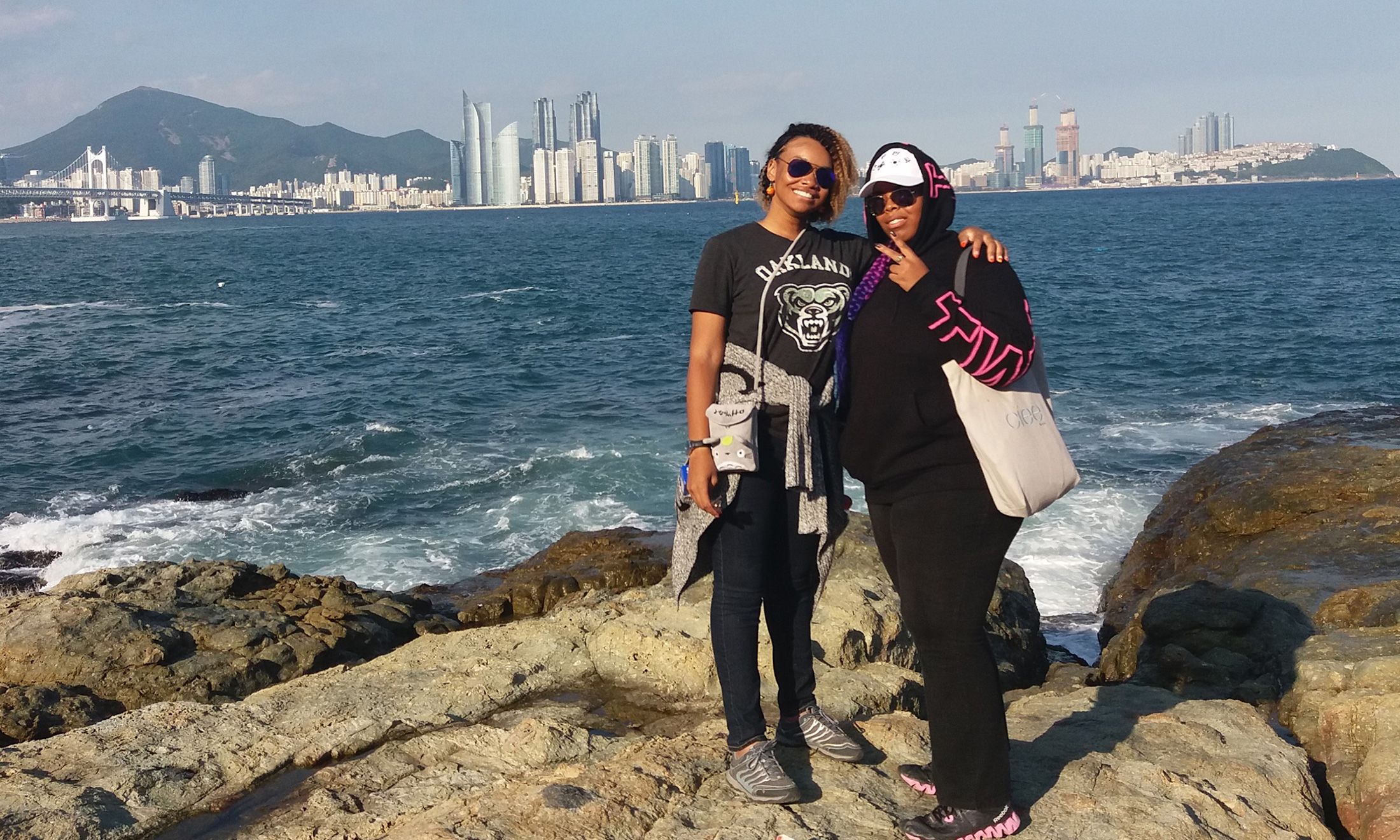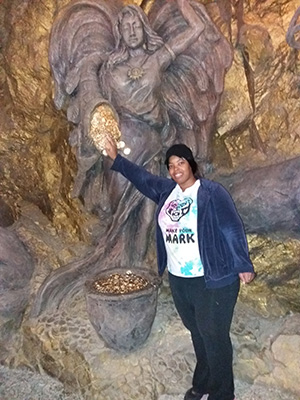- YouTube
- TikTok
Seoul Sisters
Liberal studies majors Santeiu and Nerys Butler explore new horizons during a yearlong study abroad in South Korea

Nerys (left) and Santeiu at the Seoul Peace Festival in Suwon, South Korea

Santeiu at Yeongju Museom Village, South Korea

Nerys in front of the blue negotiation buildings inside the Joint Security Area of Korea's Demilitarized Zone

Santeiu and Nerys at the shores of Busan, South Korea

Santeiu and Nerys with the students they taught at a school in Gapyeong, South Korea

Santeiu at Gwanghanru Park in Namwon, South Korea.

Beyond their familial ties, sisters Santeiu and Nerys Butler share a lot in common. They came to Oakland University as transfer students and are majoring in liberal studies with minors in international studies and anthropology. Both have a strong affinity for East Asian cultures and spent the past year studying abroad in South Korea.
Nerys at Gwangmyeong Cave wishing for good luck and prosperity |
The experience took the Romulus, Michigan residents on an eclectic journey that included visits to mountain-top Buddhist temples, a picturesque island, bustling city shops and restaurants, and the Demilitarized Zone – the buffer area that separates South Korea from its northern neighbor.
The pair were also enrolled at one of the country’s most prestigious universities. The curriculum was demanding and the atmosphere intense, the sisters said of their time at Yonsei University in Seoul. They were housed in the school’s international dorm and took a full load of classes in Korean language, history, politics and other subjects.
While balancing academics, they carved out time on nights and weekends for sightseeing, exploration and hanging out with new friends. These were just some of the highlights of a study abroad that marked their first travels beyond North American shores.
To prepare for the experience, they learned about Korean language and customs, studied maps of the country and consulted with OU’s Office of International Education. They also received guidance and scholarship support from the Council on International Educational Exchange, a nonprofit that offers study abroad opportunities in 45 countries.
After months of anticipation – and a 13-hour plane ride – the sisters landed in South Korea on August 19, 2017. Aside from the hilly, sometimes mountainous terrain and periods of intense heat, they had little difficulty adjusting to new surroundings.
“I surprised myself with how well I merged into the culture and how easily I adapted to situations,” Santeiu said. “I was told I would have issues fitting in because I am African American, but I did not. Koreans were intrigued by my hair and height, and I was constantly asked where I was from even before they said hello.”
The pair quickly acclimated themselves to the city and branched out to other places, thanks to the country’s highly developed infrastructure and subway system, which Santeiu said, “takes you almost anywhere you want to go.”
USA to DMZ: Inside Korea’s Demilitarized Zone
One of the first places they went was to Hwaeomsa Temple, where they witnessed a ceremony conducted by Buddhist monks. They also visited popular tourist and heritage sites, including Namsan Tower, Jeju Island and Gwang Myeong Cave, located on the outskirts of Seoul.
But their most memorable excursion was to the Demilitarized Zone, the 160-mile stretch that divides the Korean peninsula and serves as a meeting place for diplomatic relations between the North and the South.
Despite the demilitarized designation, the border between the two Koreas remains heavily militarized. President Clinton once called it the “scariest place on earth.” However, as Santeiu and Nerys learned, daily life in the DMZ belies its ominous reputation. It is a popular tourist destination, drawing roughly a million visitors a year, with guided tours, a gift shop, and even a museum.
“I assumed that the DMZ would be much more tense,” Santeiu said. “It was very eye-opening to see for myself how misrepresented the North Korean crisis is and how South Korea is responding to it.”
She and Nerys visited the DMZ on two occasions and set foot on North Korean ground while touring the powder blue negotiation buildings in the Joint Security Area. With its strict rules and solemn atmosphere, this area has considerably less visitors and is the only portion of the DMZ where North and South Korean soldiers directly face each other.
“I remember how quiet it was,” said Nerys. “We saw a North Korean soldier watching us making sure we weren’t doing anything wrong. But we were completely safe and accompanied by U.S. soldiers the entire time.”
Aspiring educators
Santeiu and Nerys studied at Yonsei University for two semesters. But it may have been the brief interval between those semesters that had the most impact on them.
They spent part of their break from classes teaching English to six children at a small school in rural Gapyeong, located in the northern region of South Korea. The children, who ranged in age from six to 16, were eager to learn and also share knowledge with their teachers.
‘The kids are a lot better at speaking English than they think,” Santeiu said. “They are usually very shy to speak it, and I want to give them more confidence.”
While neither of the sisters had previously considered a career in teaching, the experience struck a chord with both of them.
“It was an experience of a lifetime,” Nerys said. “We’re going to go back and teach as soon as we graduate.”
World’s ‘most wired’ |
Stressed society
In the shadows of Seoul’s towering skyscrapers, glimmering lights and futuristic amenities, the sisters saw another side to life in South Korea – one marked by street protests, homelessness and stressed out students.
“Students smoke and drink to cope with the stress of school,” Santeiu said. “There’s a lot of pressure to get good grades, get a good job, get married and have a family. There’s not a lot of freedom to choose what you want to be.”
Sometimes the pressure was evident in more subtle ways. One of the differences between the international dorms and the dorms of Korean students, Santeiu noted, were the windows. The windows of the international students could be fully opened, while those of the Korean students only opened part way.
“It was a safety precaution to prevent them from jumping out,” she said. “The suicide rate is very high in South Korea, especially among younger people. If I had a culture shock moment, that was definitely it.”
Nerys also noticed the pressure to live up to social standards.
“The society is very collective, with little to no individuality,” she explained. “Koreans are generally very friendly and accepting of foreigners who are different. But if you’re Korean, there’s pressure to conform to expectations and avoid being different. It can be hard to express yourself.”
Embracing diversity is a core value for both sisters. It’s a big reason why they chose to major in liberal studies, with its emphasis on understanding other peoples and cultures.
“It’s easy to point at a different culture and say what they’re doing is wrong, or that they should adopt our culture, without taking time to understand their perspective,” Santeiu said. “Cultural barriers need to be broken down.”
One of the best ways to achieve this, adds Nerys, is by studying abroad.
“It makes you grow as a person, it makes you more aware of yourself and your environment, and it gets you out of your comfort zone,” she said. “If you want to challenge yourself and advance in life, go study abroad.”


 August 8, 2018
August 8, 2018